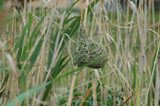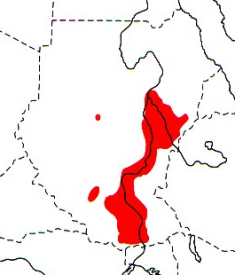Weaver species
Choose different species from drop-down list and press 'Go' button. See Full species list.Cinnamon Weaver Ploceus badius
IUCN: Least concern Discovery: 053Categories: wetland, pest,
News items about species
Discovery
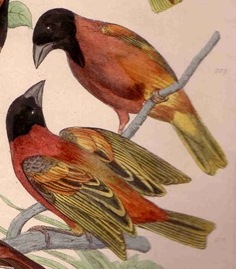
figure from Reichenbach 1863 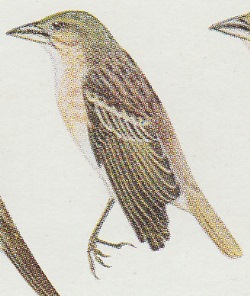
figure from Mackworth 1955 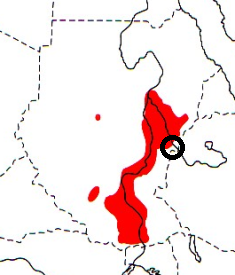
distribution, type locality circled IntroductionThe Cinnamon Weaver was formally described by John Cassin, an American ornithologist and curator of the Academy of Natural Sciences of Philadelphia (ANSP), now Academy of Natural Sciences of Drexel University.It is not known who collected the Cinnamon Weaver. The earliest record of the type specimen is in the possession of Victor Massena, Duc de Rivoli, Prince d'Esling, a French amateur ornithologist living in Paris. Rivoli had a large collection of birds, about 12500 specimens, which were bought by the Academy of Natural Sciences of Drexel University, formerly the Academy of Natural Sciences of Philadelphia (ANSP), the oldest natural science research institution and museum in the New World. The collection arrived in Philadelphia in September 1846 (Stone 1899) and Cassin described many of these specimens as new bird species, including the Cinnamon Weaver. In 1855 Charles Lucien Bonaparte, a French biologist and ornithologist, wrote that he had seen specimens of the Cinnamon Weaver as early as 1838 [presumably in the collection of Rivoli, although he was living in Italy at that time]. It is possible that Ruppell collected the Cinnamon Weaver on his Ethiopian trip in 1831 to 1834 when he reached the border with Sudan. The first illustration of a Cinnamon Weaver is a colour painting published by Cassin 1850. No more published until 1955 when several illustrations were published, including the first illustration of a female by Mackworth 1955. Scientific citationHyphantornis badius Cassin 1850 Prov. Acad. Nat. Sci. Philadelphia, 5, p.57 "Fazogloa; Eastern Africa", presumed to be Fazogli, Blue Nile, eastern Sudan.Meaning of namesbadius - Latin: badius, chestnut-coloured, reddish-brown.First English nameThe chestnut coloured Weawer (Reichenbach 1863).Alternate namesThe chestnut coloured Weawer, White Nile Cinnamon Weaver.CollectorUnknown, part of the Rivoli collection.Date collectedBefore 1838 but date unknown.Locality collectedFazogli, Blue Nile, eastern Sudan.Type specimensCassin mentioned several specimens but Stone 1899 only lists ANSP 14052 (housed in the Academy of Natural Sciences of Drexel University). |
The above is based on Weaver Wednesday 2, a weekly series about the discovery of each weaver species.
This species text first appeared as
Weaver Wednesday [170] - Discovery [53]: Cinnamon Weaver on 2015-09-16
1. Basic biology
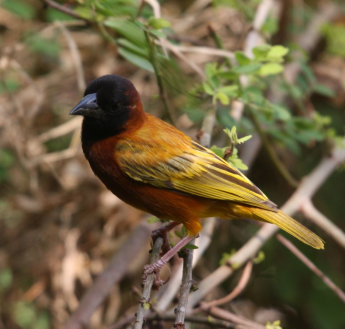

Identification.
The Cinnamon Weaver occurs in Sudan and South Sudan. The male in breeding plumage has a black head and chestnut body, closely resembling the Chestnut Weaver. The Cinnamon Weaver is distinguished from the Chestnut by yellow wing edges (rather than pale) and yellow vent (rather than brown). Also their ranges are mostly separate. Female and non-breeding male Cinnamon Weavers are sparrowy, streaked above, and with olive-green heads and yellow eye-stripes.
Distribution. The Cinnamon Weaver is found in Sudan and South Sudan, especially along the Nile River and its tributaries, as far north as 16N, and south to the Uganda border (see red on map left, based on Birds of Africa). It is common to locally abundant. It occurs in some protected areas but is apparently hunted in Bandingilo National Park. No subspecies are currently recognised. Habitat.
The Cinnamon Weaver inhabits tall grassland near rivers, with some bush and scattered trees. It is gregarious, occurring in small flocks in the non-breeding season. It roosts communally in tall trees.
Food. The diet of the Cinnamon Weaver includes seeds, but no other details are known. Breeding. The Cinnamon Weaver is colonial and may be monogamous. Colonies may be large or small. The male displays from the nest or nearby vegetation. The nest is roughly globular, with an entrance at one side. It is closely woven from grass blades and strips torn from sorghum leaves. The nest is placed 1.5-2 m above the ground or water. It is supported by vertical stems, in tall grass in flooded areas, or suspended on twigs in trees. The clutch is 2-3 eggs, which are lightly or heavily spotted. Very little is known about this species and its breeding habits. |
The above is based on Weaver Wednesday, a weekly series about weaver species.
This species text first appeared as
Weaver Wednesday [59]: Cinnamon Weaver on 2013-07-31
2. Breeding facts
| Pair bond Possibly monogamous Breeding season Sept-Oct Nest site placed 1.5-2 m above ground or water, supported by vertical stems, in tall grass in flooded areas Nest building no information Colony size Colonial Clutch size 2-3 eggs Egg colour ground colour varying from off-white to brown, green and blue, lightly or heavily spotted with black, grey, brown, purple and reddish Egg size average size 22 x 16 mm Incubation no information Chicks and nestling period no information |
Breeding information based on Handbook of the Birds of the World, Vol. 15.
3. Photos of Weaver Nests
 Vm 3054 |
Thumb-nails of most recent PHOWN records - click on one to see its full record
See all PHOWN records for this species here.
PHOWN (Photos of Weaver Nests) provides valuable info on breeding distribution and colony sizes of weavers.
You can contribute by registering and submitting photos at Virtual Museum webpage.
4. Breeding distribution
Google map showing distribution (For species with small ranges you need to zoom in at the correct area to see the range):
yellow blob - range of weaver species; read more about this here.
![]() - PHOWN records with photos
- PHOWN records with photos
![]() - PHOWN records with no photos (Nest Record Cards, other records)
- PHOWN records with no photos (Nest Record Cards, other records)
![]() - Birdpix records
- Birdpix records
![]() - comments on out of range records, or interesting records
- comments on out of range records, or interesting records
![]() - type locality
- type locality
CLICK on the marker on the map to see individual record details.
5. Range changes
Not South African speciesThe above is based on Weaver Wednesday 3, a weekly series about range changes in South African weaver species.
This species text first appeared as
n/a








